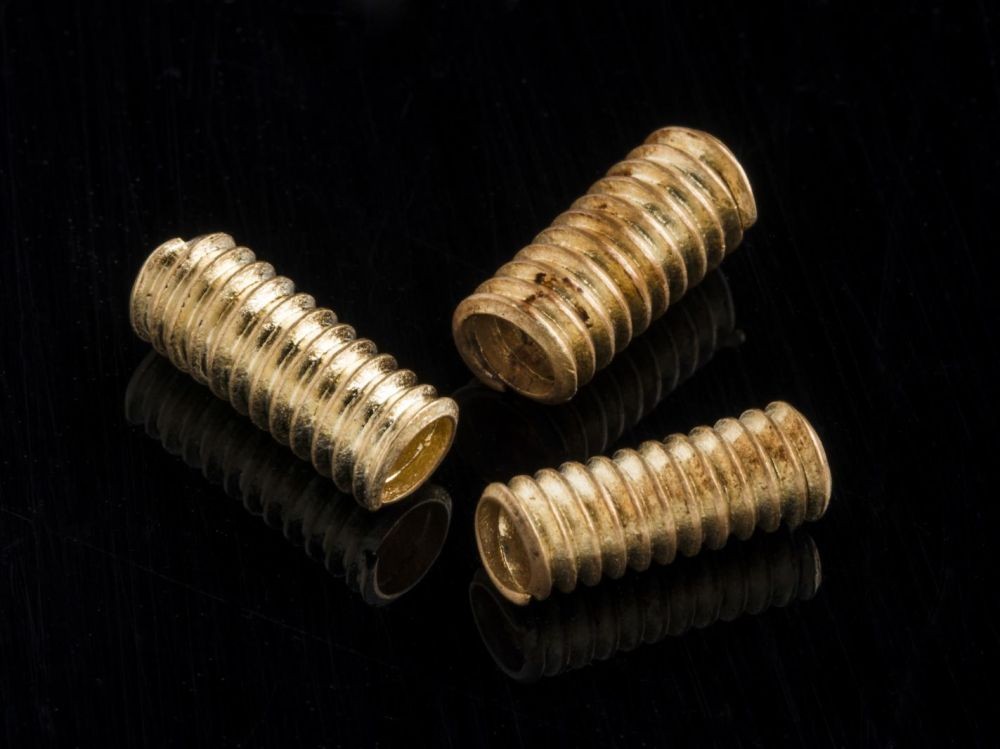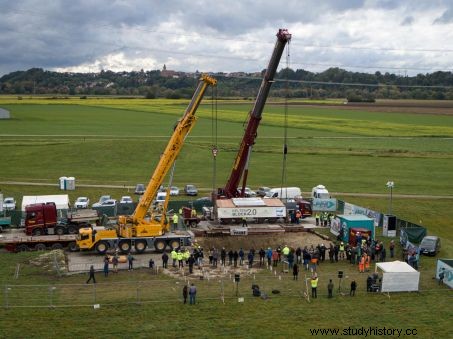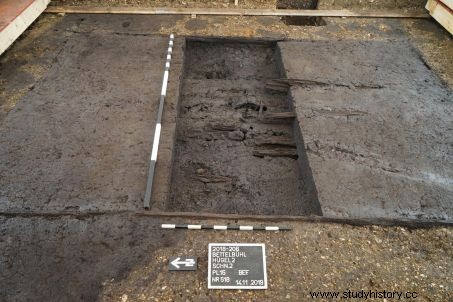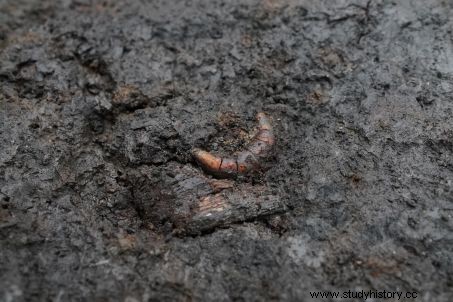On the Celtic site of Heuneburg, one of the major archaeological sites in Germany and Central Europe, the excavation of a new burial suggests that a noble lady was buried in a ceremonial burial chamber. Similar to that of the Princess of Bettelbühl, excavated from 2010, this new campaign gives hope for future discoveries on the Celtic culture of Hallstatt.

Three tubular gold ribbed beads found in the burial chamber of tumulus no. 2 of the Bettelbühl necropolis, on the archaeological site of Heuneburg (Baden-Württemberg).
Located in the Land of Baden-Württemberg, near the Danube, the Heuneburg is considered the oldest urban complex north of the Alps and is one of the prehistoric highlights of Germany and Central Europe. Between the 7th and 5th centuries BC, which corresponds to the period of the final Hallstatt of the Iron Age, there stood a princely residence of the first Celts, similar to that of Mont-Lassois (Vix) in France. , gathering around an acropolis a lower town fortified by an adobe wall, an external agglomeration and neighboring necropolises. Archaeological research carried out on the site since the end of the 19th century has shown that this complex was certainly the seat of centralized power, similar to the great ancient cities of Eurasia and the Mediterranean basin. These could have served as a model, this residence having probably housed several thousand inhabitants at its peak. Over the past twenty years, new archaeological techniques such as dendrochronology, isotopic analyses, LIDAR imaging, or 3D modeling have led to crucial discoveries that have renewed understanding of the Heuneburg.
The necropolis of Bettelbühl
While the excavations carried out since the 1950s have investigated the different residential areas of the agglomeration, over the last decade, it is rather the necropolis of Bettelbühl, located on the opposite bank of the Danube, below the site, which is reveals an exceptional source of information. Archaeologists have identified seven burial mounds there, of which only burial No. 1 is particularly visible, due to its height of nearly 4 meters. In 2005, the fortuitous discovery, during plowing, of a gold fibula on the site of tumulus n°4 triggered the start of excavations. On site, archaeologists from the Baden-Württemberg Historical Monuments Protection Service (LAD) unearthed a tomb in which lay a little girl of about three years old, surrounded by rich furniture and gold jewelry. They realize, however, that this burial is actually attached to another, much larger one, which was extracted in December 2010 in order to be analyzed without suffering any damage.
The main burial chamber houses two bodies of women. The first, aged about 30 at the time of her death, is covered with jewelery in gold, amber, copper and sapropel (pseudo-jay) imported from Dorset – there are not only fibulae, but also multiple beads (including fluted tubular beads) formerly assembled into a necklace, pendants, a belt, numerous bracelets, and two ankle rings. The second, on the other hand, is more modestly endowed with a single set of jewellery. The richness of the furniture, as well as the size and craftsmanship of the jewelry indicate that the first woman buried, in the meantime nicknamed "the princess of Bettelbühl", most certainly belonged to the elite. The dendrochronological dating of the oak and fir wood constituting the floor of the funerary chamber made it possible to date very precisely the burial, which took place during the second half of the year 583 before our era.
A raw materials exchange network beyond the Alps
This tomb provided essential information to archaeologists, because all the burials which had hitherto been excavated on the site of the Heuneburg, and which were located closer to the fortified city, had been looted. For the director of the excavations, Dirk Krausse, the objects found in these two burials of Bettelbühl (those of the two women and that of the child), like the adobe architecture of Mediterranean influence, indicate that the Heuneburg was part of a network for the exchange of raw materials, manufactured goods, information and services beyond the Alps. Because the jewels and other objects in gold and amber, as well as the elements of harness - we indeed found the muzzle of a horse (the piece of armor which protected the front of its head), which was to be connected to an elaborate bridle with bells and boar's teeth, the remains of which also remain – suggest links with the Italian peninsula, where these techniques were mastered. Moreover, the archaeologists have discovered that certain pieces of goldsmithery (those made of twisted gold wire) were undoubtedly manufactured on site.
Located in the Land of Baden-Württemberg, near the Danube, the Heuneburg is considered the oldest urban complex north of the Alps and is one of the prehistoric highlights of Germany and Central Europe. Between the VII th and the V e century before our era, which corresponds to the period of the final Hallstatt of the Iron Age, there stood a princely residence of the first Celts, similar to that of Mont-Lassois (Vix) in France, gathering around a acropolis a lower town fortified by an adobe wall, an outer settlement and neighboring necropolises. Archaeological research carried out on the site since the end of the 19 th century have made it possible to demonstrate that this complex was certainly the seat of a centralized power, similar to the great ancient cities of Eurasia and the Mediterranean basin. These could have served as a model, this residence having probably housed several thousand inhabitants at its peak. Over the past twenty years, new archaeological techniques such as dendrochronology, isotopic analyses, LIDAR imaging, or 3D modeling have led to crucial discoveries that have renewed understanding of the Heuneburg.
The necropolis of Bettelbühl
While the excavations carried out since the 1950s have investigated the different residential areas of the agglomeration, over the last decade, it is rather the necropolis of Bettelbühl, located on the opposite bank of the Danube, below the site, which is reveals an exceptional source of information. Archaeologists have identified seven burial mounds there, of which only burial No. 1 is particularly visible, due to its height of nearly 4 meters. In 2005, the fortuitous discovery, during plowing, of a gold fibula on the site of tumulus n°4 triggered the start of excavations. On site, archaeologists from the Baden-Württemberg Historical Monuments Protection Service (LAD) unearthed a tomb in which lay a little girl of about three years old, surrounded by rich furniture and gold jewelry. They realize, however, that this burial is actually attached to another, much larger one, which was extracted in December 2010 in order to be analyzed without suffering any damage.
The main burial chamber houses two bodies of women. The first, aged around 30 at the time of her death, is covered with jewelery in gold, amber, copper and sapropel (pseudo-jay) imported from Dorset – there are not only fibulae, but also multiple beads (including fluted tubular beads) formerly assembled into a necklace, pendants, a belt, numerous bracelets, and two ankle rings. The second, on the other hand, is more modestly endowed with a single set of jewellery. The richness of the furniture, as well as the size and craftsmanship of the jewelry indicate that the first woman buried, in the meantime nicknamed "the princess of Bettelbühl", most certainly belonged to the elite. The dendrochronological dating of the oak and fir wood constituting the floor of the funerary chamber made it possible to date very precisely the burial, which took place during the second half of the year 583 before our era.
A raw materials exchange network beyond the Alps
This tomb provided essential information to archaeologists, because all the burials which had hitherto been excavated on the site of the Heuneburg, and which were located closer to the fortified city, had been looted. For the director of the excavations, Dirk Krausse, the objects found in these two burials of Bettelbühl (those of the two women and that of the child), like the adobe architecture of Mediterranean influence, indicate that the Heuneburg was part of a network for the exchange of raw materials, manufactured goods, information and services beyond the Alps. Because the jewels and other objects in gold and amber, as well as the elements of harness - we indeed found the muzzle of a horse (the piece of armor which protected the front of its head), which was to be connected to an elaborate bridle with bells and boar's teeth, the remains of which also remain – suggest links with the Italian peninsula, where these techniques were mastered. Moreover, the archaeologists have discovered that certain pieces of goldsmithery (those made of twisted gold wire) were undoubtedly manufactured on site.
A focus on tumulus n°2
In order to find out more, excavations therefore resumed in the necropolis in 2018, now focused on the area of tumulus n°2. On the spot, the archaeologists were able to observe that many organic materials (construction wood, but also funerary objects in plant trellis) were partially preserved. More than by crossing the centuries, these rare materials and therefore of exceptional scientific value have however been damaged due to the extreme drought that has raged in Germany in recent years. Archaeologists therefore felt that a block extraction was absolutely necessary before climate change came to complete their destruction.

Block extraction of the Celtic tomb from Tumulus No. 2 near the Heuneburg, October 6, 2020. © Christoph Steffen / Markus Steffen
As for tumulus n°4, the whole of the burial chamber was therefore recovered as a whole in October 2020. The hopes of the scientists justify the means implemented, because the block containing the burial chamber, 8 meters long by 6 (the chamber itself is 5 by 3 meters), weighed almost 80 tons and had to be lifted by two cranes to be transported to the LAD laboratories. The block is only a meter high, because over time the ceiling of the chamber collapsed under the weight of the sediments, crushing all its contents into a compact layer a few centimeters thick. It was this layer that was then examined by the archaeologists, restorers and natural scientists of the LAD under the direction of Professor Dirk Krausse. In July 2021, the chief curator of the LAD, Professor Claus Wolf, presented the first elements brought to light.
The burial of a noble lady
The first discoveries demonstrated that tumulus n°2 housed the richly furnished tomb of a woman of higher social class, who must have worn precious jewels of high quality workmanship. 15 ribbed tubular gold beads have indeed been found, which must originally have belonged to a splendid necklace. An exceptional amber brooch could come from the Baltic Sea region, Italy or Slovenia. Archaeologists have also found bronze objects, probably corresponding to the equipment of a four-wheeled wooden chariot, some elements of which would also be preserved in this tomb, which would be exceptional, since no one has yet been found. wooden part of the first Celtic chariots. Finally, pottery and a pig skeleton represent offerings of drink and food, which were given to the deceased on her way to the afterlife.

Section for probing inside the burial chamber. You can clearly see the protruding timbers, some of which could belong to a tank. © Michael Lingnau / Landesamt für Denkmalpflege im Regierungspräsidium Stuttgart
The analysis of the floor of the funerary chamber, made up of oak planks, has not yet been completed, but it already appears that various elements have been moved several times, due to natural factors, such as the infiltration of water in the first years after burial, but also following an opening of the burial chamber in ancient times.
It therefore seems unlikely that more precious objects will be discovered. The opening of the tomb and the fact that archaeologists have not yet found any large funerary objects suggest that the tomb was looted, probably a few years or decades after the burial. There would therefore remain in this burial only the small objects, left behind by the thieves in the rush.
A relative of the Princess of Bettelbühl?
These first analyzes of the remains of tomb no. 2 reveal similarities with the tomb of the "princess of Bettelbühl", which was located only a hundred meters away, under tumulus no. 4 of the necropolis, and which was recovered by the LAD in 2010. Scientists believe that it is likely that tomb no. 2 was originally also richly furnished and decorated, and that these two women could be linked by their social status.
This is why the tomb of the noble lady of tumulus n°2 represents a challenge for researchers. Despite the loss of concrete elements caused by its early looting, they first of all wish to continue the campaign to uncover and restore the contents of the funerary chamber, in order to be able to reconstitute the original furniture by 2022. the grave from all the elements found in the humus. Their ultimate and ideal goal would then be to discover the identity of these noble women:"We want to find out who these splendidly buried people are and what their relations were. We assume that they are close relatives of politically influential families who ruled the Heuneburg around 600 BC ", says Dirk Krausse.

The amber brooch where it was found. A similar piece was discovered in 2010, on the mound of the "Princess of Bettelbühl", just 100 meters from the current excavation site. No other examples of amber brooches north of the Alps are known. © Michael Lingnau / Landesamt für Denkmalpflege im Regierungspräsidium Stuttgart
One thing is certain:a complete examination of the tomb, its structure, human remains, objects and jewelry found will provide crucial information on the history and culture of the early Celts. The necropolis of Bettelbühl in fact shelters the oldest of a series of female tombs containing gold furniture found north of the Alps (like that of the lady of Vix in France); we therefore hope that it is still far from having revealed all its secrets.
